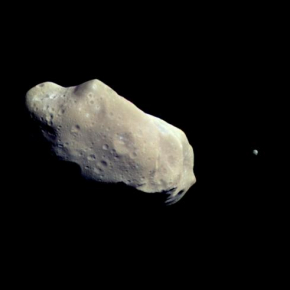Compared to the satellites of planets, the study of asteroid satellites is a relatively young science. The motion of these satellites is mainly governed by the gravity field generated by their main asteroid.

However, while studying the dynamical system of the asteroid (379) Huenna and its satellite, DeMeo and his scientific colleagues (2011, Icarus, 212) had reported a discrepancy between its predicted and observed position.
To understand this discrepancy, three French researchers have compiled all available images of this system, acquired with large ground-based telescopes equipped with an adaptive optics camera. That is to say forty observations in total, over a period of 11 years.

The influence of the Sun
Based on these images, they determined that the satellite’s orbit is strongly affected by the gravitational influence of the Sun, unlike what is observed on satellites of large main belt asteroids.
The satellite orbits the asteroid (379) Huenna at a distance of about 3 500 km, over a period of 80 Earth days. This distance is relatively high, and the mass of the asteroid is quite low. The gravity field that the asteroid generates towards its satellite is in fact tenuous and allows the Sun to act on the movement of the satellite during a short period of time.
Gravity is a law that depends on the distance between objects. When the satellite is closer to the Sun than to the asteroid around which it rotates, it suffers a little more from the Sun’s gravity than from the asteroid’s.
Conversely, when it is farther from the Sun, it is the asteroid that suffers a little more. The results, covering a period of 11 years of observation confirm the influence of the Sun on the orbit of the satellite.
Among all the asteroids known to date, another asteroid of the main belt, (3749) Balam, could present this same characteristic.
References
This work is the subject of an article published online on April 9, 2022 on the website of the journal Icarus, under the title "Dynamics of the binary asteroid (379) Huenna".

